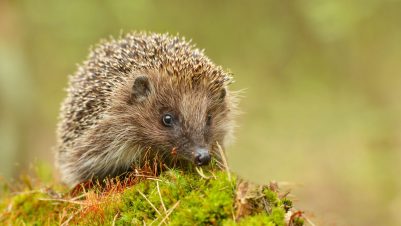Invertebrates make up anything between 95 percent and 98 percent of all animal species (May, 1988), but they can be somewhat of a mystery when their care requirements in captivity are considered. Several invertebrate species are commonly kept as household pets, such as Indian green stick insects (Carausius morosus) and giant African land snails (Lissachatina fulica, Achatina achatina). While they may appear to have less substantial management and care needs compared to a dog or a cat, they will require correct housing, feeding, social grouping and environmental conditions to remain healthy and to thrive.
At the other end of the scale, the keeping of exotic invertebrates can be a very specialist hobby, with numerous societies existing that cater to experienced enthusiasts and that provide access to a wide range of species. Flower beetles (subfamily Cetoniinae), praying mantises (order Mantodae), tarantulas (family Theraphosidae), scorpions (order Scorpiones), grasshoppers and katydids (order Orthoptera), and even marine corals and marine crustaceans can all be kept at home.
What are the welfare requirements for invertebrates?
Invertebrates may not show signs of poor health and therefore may not present welfare challenges as readily as vertebrates such as companion animals. However, this is not to say that they are immune from the negative effects of poor welfare. Inappropriate environmental conditions, such as incorrect heating, lighting and humidity, or the wrong social group or enclosure set-up can result in an invertebrate not thriving.
Invertebrates may easily be dismissed as more simple creatures, but they can be as complex in their physiology and behaviour as any “higher vertebrate”
Many species are capable of problem-solving behaviours, for example the cephalopods (octopus for example) and are considered to be sentient. In fact, the common octopus (Octopus vulgaris) was included in the Animals (Scientific Procedures) Act 1986, as amended 1993, to emphasise the complexity of invertebrate species and their potential to be aware of suffering and distress. Interestingly, this Act has been further updated in 2013 to include all cephalopods and the Animal Welfare (Sentience) Act 2022 has made provisions for the protection of cephalopods and decapod crustaceans (eg lobsters and crabs) as sentient beings. Invertebrates may easily be dismissed as more simple creatures, but they can be as complex in their physiology and behaviour as any “higher vertebrate”.
Signs of good invertebrate care
Unlike cats and dogs which have been domesticated for greater adjustment into a human-centric world, exotic pet invertebrates are not domesticated and will retain the behaviours and ecological needs of their wild ancestors
As with more familiar vertebrate pets, invertebrate species that are commonly perceived as exotic pets have evolved to live in a specific ecological niche and, therefore, require environmental conditions to mimic their wild habitat. Unlike cats and dogs which have been domesticated for greater adjustment into a human-centric world, exotic pet invertebrates are not domesticated and will retain the behaviours and ecological needs of their wild ancestors.
Figure 1 provides an example of a Malaysian leaf katydid (Ancylecha fenestrata) within a biologically relevant enclosure. It details the physical and behavioural signs of welfare and health (the outputs from the animal that can be described and assessed) compared to the physical structure of the environment and the resources that the animal engages with (the inputs that will influence welfare state). As with vertebrate pets, health conditions and welfare challenges can be judged on how the animal is being cared for and how it is responding to its care.

Environment
When invertebrates are kept in more complex systems, the wide-ranging interactions between invertebrates and other species can allow their owner to see a snapshot of the wild in their own home (ie captivity). For example, the creation of a marine coral reef in the home aquarium may house hard (with a calcium carbonate exoskeleton) and soft (no calcified exoskeleton) corals, anemones (order Actiniaria) and crustaceans such as cleaner shrimps (Lysmata amboinensis) – that, by the way, do an excellent job of cleaning away parasites and dead or damaged tissues from other organisms to keep the wider environment healthy. Figure 2 provides an example of an environmental set-up that promotes growth and development for a wide range of specimens, including aquatic marine invertebrates.

Life cycle implications
Many invertebrates have specific stages of their life cycle when they are especially prone to poor welfare and increased mortality if environmental conditions are not correct for that stage in their development. Moulting out of an old exoskeleton into a new one, for example, or metamorphosis from a larval or sub-adult form into a mature adult are physiologically challenging times. Invertebrates need to be handled with care. They are not always robust enough to withstand knocks, bumps, tight grasps and falls from height. If dropped, or held incorrectly, splits or cracks in the exoskeleton of some species can cause haemolymph (analogous to blood in vertebrates) to leak out causing a disruption to respiration as well as to fluid and electrolyte balances, which can be fatal. Aquatic invertebrates can become damaged in transit and may need time to recuperate and regenerate body parts in a quieter, quarantine set-up before they move into a busier “main” aquarium.
Many invertebrates have specific stages of their life cycle when they are especially prone to poor welfare and increased mortality if environmental conditions are not correct for that stage in their development
Behaviour
Many invertebrates are also prey species and, therefore, their behaviour needs to be considered and evaluated with this in mind. Snails will retreat inside their shells, some insects (for example black beauty stick insects (Peruphasma schultei) that are common in the pet trade) can secrete a noxious liquid if they feel threatened and others, such as Macleay’s spectre (Extatosoma tiaratum), may have sharpened parts of their exoskeleton which can puncture human skin when used in defence.
Summary

It is important to consider the invertebrate’s response to its human owners when judging its physical appearance, its behaviour and any other indicators of stress. The more we understand about the form and function, anatomy, physiology and morphology, behaviour and ecology of the invertebrate species being housed under human care, the better the chances are of stepping in when a health and welfare issue starts to become apparent, and to provide appropriate solutions or treatments. The huge diversity of invertebrates (Figure 3) means that we are currently only scratching the surface of evidence-based care for this myriad of species.










